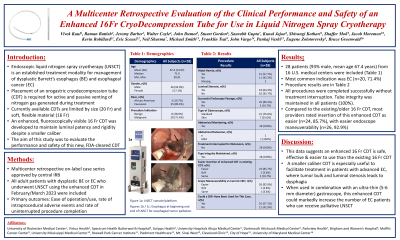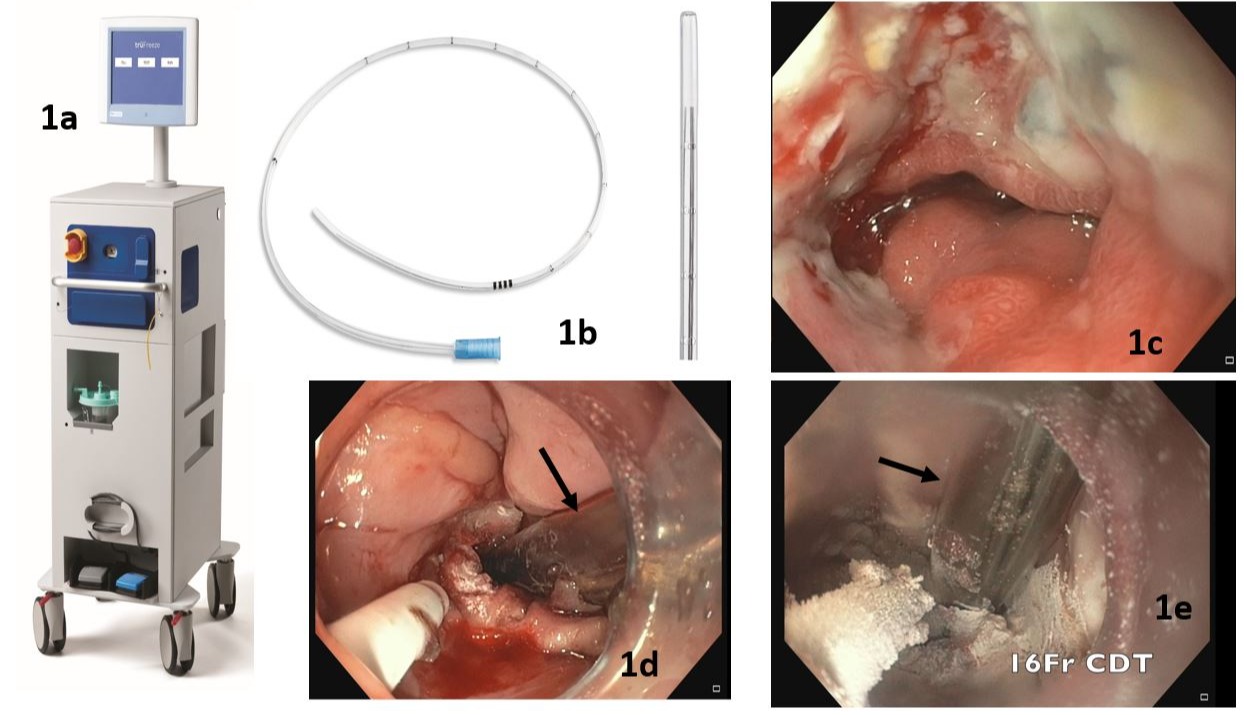Monday Poster Session
Category: Esophagus
P1832 - A Multicenter Retrospective Evaluation of the Clinical Performance and Safety of an Enhanced 16 Fr CryoDecompression Tube for Use in Liquid Nitrogen Spray Cryotherapy
Monday, October 23, 2023
10:30 AM - 4:15 PM PT
Location: Exhibit Hall

- VK
Vivek Kaul, MD, FACG
University of Rochester
Rochester, NY
Presenting Author(s)
Award: Presidential Poster Award
Vivek Kaul, MD, FACG1, Jeremy Barber, DO2, Raman Battish, MD3, Walter Coyle, MD4, John Dumot, DO5, Stuart R. Gordon, MD6, Saurabh Gupta, MD7, Kunal Jajoo, MD8, Shivangi Kothari, MD1, Shaffer R. S.. Mok, MD9, Jacob Moremen, MD10, Kevin Robillard, MD11, Eric Sceusi, MD12, Neil R.. Sharma, MD13, Michael S.. Smith, MD, MBA14, Franklin Tsai, MD4, John Vargo, MD15, Pankaj Vashi, MD16, Eugene Zolotarevsky, MD17, Bruce Greenwald, MD18
1University of Rochester, Rochester, NY; 2Corewell Health, Grand Rapids, MI; 3Virtua Health System/Virtua Medical Group, Cherry Hill, NJ; 4Scripps Clinic, La Jolla, CA; 5University Hospitals Cleveland Medical Center, Cleveland, OH; 6Dartmouth-Hitchcock Medical Center, Lebanon, NH; 7Sutter Health, San Francisco, CA; 8Brigham and Women's Hospital, Boston, MA; 9Moffitt Cancer Center, Tampa, FL; 10University of Mississippi Medical, Jackson, MS; 11Roswell Park Cancer Institute, Buffalo, NY; 12Piedmont Heart Institute, Atlanta, GA; 13Parkview Cancer Institue, Fort Wayne, IN; 14Icahn School of Medicine at Mount Sinai, New York, NY; 15Cleveland Clinic, Cleveland, OH; 16City of Hope - Chicago, Zion, IL; 17Corewell Health West, Grand Rapids, MI; 18University of Maryland, Baltimore, MD
Introduction: Endoscopic liquid nitrogen spray cryotherapy (LNSCT) is an established treatment modality for management of dysplastic Barrett’s esophagus (BE) and esophageal cancer (EC). Placement of an orogastric decompression tube (CDT) is required for active and passive venting of nitrogen gas generated during treatment. Currently available CDTs are limited by size (20 Fr) and soft, flexible material (16 Fr). An enhanced, fluoroscopically visible 16 Fr CDT was developed to maintain luminal patency and rigidity despite a smaller caliber. The aim of this study was to evaluate the performance and safety of this new, FDA-cleared CDT.
Methods: This multicenter retrospective on-label case series was approved by central IRB. All adult patients with dysplastic BE or EC who underwent LNSCT using the enhanced CDT in February/March 2023 were included. Primary outcomes included ease of operation/use, rate of intraprocedural adverse events and rate of uninterrupted procedure completion.
Results: A total of 28 patients (93% male, mean age 67.4 years) from 16 U.S. medical centers met inclusion criteria (Table 1). The most common indication was EC (20, 71.4%). There were 15 patients (57.7%) with a hiatal hernia and 18 patients (64.3%) with luminal stenosis; 3 (10.7%) had narrowing which prohibited endoscope passage. In 12 cases (42.9%), the endoscopist felt a 20Fr CDT could not have been used (due to luminal stenosis). A standard gastroscope was used for most cases (21, 75%). All patients had intraprocedural abdominal monitoring, with only 1 (3.6%) experiencing mild abdominal distension. All procedures were completed successfully without treatment interruption. Tube integrity was maintained in all patients (100%). Compared to the existing/older 16 Fr CDT, most providers rated insertion of this enhanced CDT as easier (24, 87.5%), with easier endoscope maneuverability (26, 92.9%).
Discussion: To date, LNSCT users have had to choose between ease of per-oral CDT insertion and maintenance of adequate decompression during treatment. These data suggest an enhanced 16 Fr CDT is safe, effective and easier to use than the existing (older) 16 Fr CDT. A smaller caliber CDT is especially useful to facilitate treatment in patients with advanced EC, where tumor bulk and luminal stenosis leads to dysphagia. When used in combination with an ultra-thin (5-6 mm diameter) gastroscope, this enhanced CDT could markedly increase the number of EC patients who can receive palliative LNSCT.

Disclosures:
Vivek Kaul, MD, FACG1, Jeremy Barber, DO2, Raman Battish, MD3, Walter Coyle, MD4, John Dumot, DO5, Stuart R. Gordon, MD6, Saurabh Gupta, MD7, Kunal Jajoo, MD8, Shivangi Kothari, MD1, Shaffer R. S.. Mok, MD9, Jacob Moremen, MD10, Kevin Robillard, MD11, Eric Sceusi, MD12, Neil R.. Sharma, MD13, Michael S.. Smith, MD, MBA14, Franklin Tsai, MD4, John Vargo, MD15, Pankaj Vashi, MD16, Eugene Zolotarevsky, MD17, Bruce Greenwald, MD18. P1832 - A Multicenter Retrospective Evaluation of the Clinical Performance and Safety of an Enhanced 16 Fr CryoDecompression Tube for Use in Liquid Nitrogen Spray Cryotherapy, ACG 2023 Annual Scientific Meeting Abstracts. Vancouver, BC, Canada: American College of Gastroenterology.
Vivek Kaul, MD, FACG1, Jeremy Barber, DO2, Raman Battish, MD3, Walter Coyle, MD4, John Dumot, DO5, Stuart R. Gordon, MD6, Saurabh Gupta, MD7, Kunal Jajoo, MD8, Shivangi Kothari, MD1, Shaffer R. S.. Mok, MD9, Jacob Moremen, MD10, Kevin Robillard, MD11, Eric Sceusi, MD12, Neil R.. Sharma, MD13, Michael S.. Smith, MD, MBA14, Franklin Tsai, MD4, John Vargo, MD15, Pankaj Vashi, MD16, Eugene Zolotarevsky, MD17, Bruce Greenwald, MD18
1University of Rochester, Rochester, NY; 2Corewell Health, Grand Rapids, MI; 3Virtua Health System/Virtua Medical Group, Cherry Hill, NJ; 4Scripps Clinic, La Jolla, CA; 5University Hospitals Cleveland Medical Center, Cleveland, OH; 6Dartmouth-Hitchcock Medical Center, Lebanon, NH; 7Sutter Health, San Francisco, CA; 8Brigham and Women's Hospital, Boston, MA; 9Moffitt Cancer Center, Tampa, FL; 10University of Mississippi Medical, Jackson, MS; 11Roswell Park Cancer Institute, Buffalo, NY; 12Piedmont Heart Institute, Atlanta, GA; 13Parkview Cancer Institue, Fort Wayne, IN; 14Icahn School of Medicine at Mount Sinai, New York, NY; 15Cleveland Clinic, Cleveland, OH; 16City of Hope - Chicago, Zion, IL; 17Corewell Health West, Grand Rapids, MI; 18University of Maryland, Baltimore, MD
Introduction: Endoscopic liquid nitrogen spray cryotherapy (LNSCT) is an established treatment modality for management of dysplastic Barrett’s esophagus (BE) and esophageal cancer (EC). Placement of an orogastric decompression tube (CDT) is required for active and passive venting of nitrogen gas generated during treatment. Currently available CDTs are limited by size (20 Fr) and soft, flexible material (16 Fr). An enhanced, fluoroscopically visible 16 Fr CDT was developed to maintain luminal patency and rigidity despite a smaller caliber. The aim of this study was to evaluate the performance and safety of this new, FDA-cleared CDT.
Methods: This multicenter retrospective on-label case series was approved by central IRB. All adult patients with dysplastic BE or EC who underwent LNSCT using the enhanced CDT in February/March 2023 were included. Primary outcomes included ease of operation/use, rate of intraprocedural adverse events and rate of uninterrupted procedure completion.
Results: A total of 28 patients (93% male, mean age 67.4 years) from 16 U.S. medical centers met inclusion criteria (Table 1). The most common indication was EC (20, 71.4%). There were 15 patients (57.7%) with a hiatal hernia and 18 patients (64.3%) with luminal stenosis; 3 (10.7%) had narrowing which prohibited endoscope passage. In 12 cases (42.9%), the endoscopist felt a 20Fr CDT could not have been used (due to luminal stenosis). A standard gastroscope was used for most cases (21, 75%). All patients had intraprocedural abdominal monitoring, with only 1 (3.6%) experiencing mild abdominal distension. All procedures were completed successfully without treatment interruption. Tube integrity was maintained in all patients (100%). Compared to the existing/older 16 Fr CDT, most providers rated insertion of this enhanced CDT as easier (24, 87.5%), with easier endoscope maneuverability (26, 92.9%).
Discussion: To date, LNSCT users have had to choose between ease of per-oral CDT insertion and maintenance of adequate decompression during treatment. These data suggest an enhanced 16 Fr CDT is safe, effective and easier to use than the existing (older) 16 Fr CDT. A smaller caliber CDT is especially useful to facilitate treatment in patients with advanced EC, where tumor bulk and luminal stenosis leads to dysphagia. When used in combination with an ultra-thin (5-6 mm diameter) gastroscope, this enhanced CDT could markedly increase the number of EC patients who can receive palliative LNSCT.

Figure: Images Demonstrating LNSCT console, 16Fr Enhanced Cryodecompression Tube and Procedure Images from a Patient with Advanced Esophageal Cancer who Underwent LNSCT Using the Enhanced CDT
1a: LNSCT console/platform
1b: Enhanced 16Fr CDT with close up view of fluoroscopically visible distal tip of the tube
1c: Distal esophagus with advanced, lumen constricting esophageal tumor
1d & 1e: Esophagus at beginning and end of LNSCT for esophageal tumor palliation, showing the spray catheter (white catheter) and enhanced 16Fr CDT (black arrow) in place
1a: LNSCT console/platform
1b: Enhanced 16Fr CDT with close up view of fluoroscopically visible distal tip of the tube
1c: Distal esophagus with advanced, lumen constricting esophageal tumor
1d & 1e: Esophagus at beginning and end of LNSCT for esophageal tumor palliation, showing the spray catheter (white catheter) and enhanced 16Fr CDT (black arrow) in place
Disclosures:
Vivek Kaul: CASTLE BIOSCIENCES – Consultant. CDX DIAGNOSTICS – Consultant. COOK MEDICAL – Consultant. MOTUS GI – Consultant. STERIS – Consultant.
Jeremy Barber: Boston Scientific – Consultant. Pentax Medical – Consultant.
Raman Battish indicated no relevant financial relationships.
Walter Coyle: Abbvie Pharma – Speakers Bureau. Regeneron Pharma – Speakers Bureau.
John Dumot indicated no relevant financial relationships.
Stuart Gordon: Boston Scientific – Consultant.
Saurabh Gupta indicated no relevant financial relationships.
Kunal Jajoo indicated no relevant financial relationships.
Shivangi Kothari: Boston scientific – Consultant. Castle Biosciences – Advisory Committee/Board Member. Olympus – Consultant.
Shaffer Mok: Conmed – Consultant. Steris – Consultant.
Jacob Moremen indicated no relevant financial relationships.
Kevin Robillard indicated no relevant financial relationships.
Eric Sceusi indicated no relevant financial relationships.
Neil Sharma indicated no relevant financial relationships.
Michael Smith: Castle Biosciences – Consultant. CDx Laboratories – Consultant. Lucid Diagnostics – Consultant. Provation Medical – Consultant. Steris Endoscopy – Consultant.
Franklin Tsai indicated no relevant financial relationships.
John Vargo indicated no relevant financial relationships.
Pankaj Vashi indicated no relevant financial relationships.
Eugene Zolotarevsky indicated no relevant financial relationships.
Bruce Greenwald: Steris – Consultant.
Vivek Kaul, MD, FACG1, Jeremy Barber, DO2, Raman Battish, MD3, Walter Coyle, MD4, John Dumot, DO5, Stuart R. Gordon, MD6, Saurabh Gupta, MD7, Kunal Jajoo, MD8, Shivangi Kothari, MD1, Shaffer R. S.. Mok, MD9, Jacob Moremen, MD10, Kevin Robillard, MD11, Eric Sceusi, MD12, Neil R.. Sharma, MD13, Michael S.. Smith, MD, MBA14, Franklin Tsai, MD4, John Vargo, MD15, Pankaj Vashi, MD16, Eugene Zolotarevsky, MD17, Bruce Greenwald, MD18. P1832 - A Multicenter Retrospective Evaluation of the Clinical Performance and Safety of an Enhanced 16 Fr CryoDecompression Tube for Use in Liquid Nitrogen Spray Cryotherapy, ACG 2023 Annual Scientific Meeting Abstracts. Vancouver, BC, Canada: American College of Gastroenterology.

